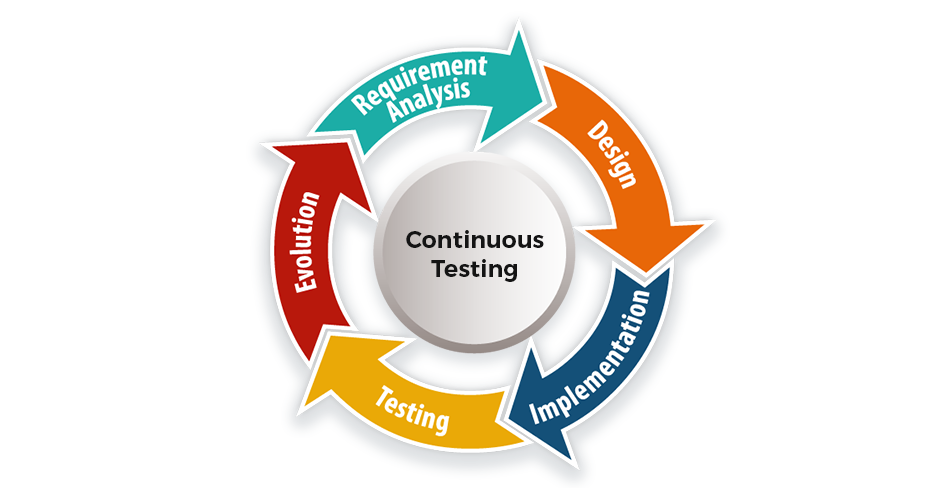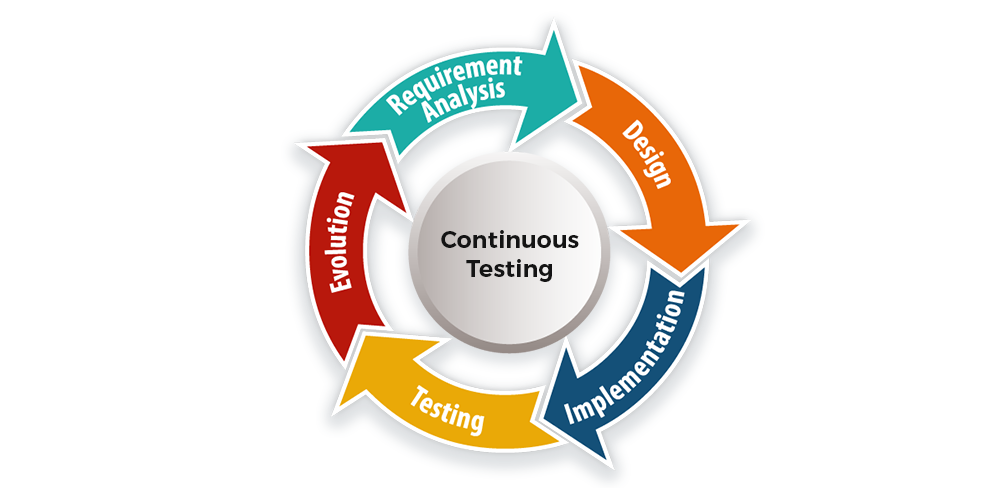Software delivery speeds continue to accelerate in the era of agile and DevOps. Businesses are demanding faster release cycles to seize opportunities and stay competitive. But how can teams ship software faster without compromising on quality? This is where continuous testing comes in.
Continuous testing is the key enabler for frequent software releases. By automatically executing tests throughout the development pipeline, it provides the rapid feedback needed to iterate quickly. However, reaping these benefits requires upfront investment and a strong testing culture.
This comprehensive guide examines continuous testing in depth. It outlines the core principles, top benefits, common pitfalls, and best practices compiled from my decade of experience in test automation and data analytics. Let‘s dive in.
What is Continuous Testing?
Continuous testing is the practice of executing automated tests across functional and non-functional requirements at every stage of the software delivery lifecycle. It validates each code change against key business risks to provide immediate feedback.
Here are some fundamental principles of continuous testing:
-
Automated – Tests are scripts or code that execute without manual intervention. Automation is essential to enable continuous execution.
-
Comprehensive – All test types are included – unit, integration, API, security, performance, etc. Full test suites are automated.
-
Frequent – Tests run early and often on every code change, not just during testing phases. Frequency provides rapid feedback.
-
Integrated – Testing is embedded into the CI/CD pipeline, not a separate phase. Code and tests are versioned together.
-
Risk-Based – Tests focus on validating business risks vs. requirements coverage. Priority is on critical user journeys.
-
Reliable – Test suites are robust and stable. Flaky tests that fail intermittently get fixed quickly.
-
Fast – Test suites execute rapidly to provide quick feedback. Performance optimizations prevent slowness.
Properly implementing these principles is key to realizing the benefits of continuous testing.
Continuous vs. Automated vs. Manual Testing
It‘s important to understand that continuous, automated, and manual testing are distinct but complementary approaches.
Automated Testing focuses on scripting test scenarios for execution without manual intervention. It may only cover a portion of test cases that make sense to automate.
Manual Testing involves human testers executing test cases manually. It provides insight automated tests may miss but does not scale well.
Continuous Testing expands automated testing to business risk validation. Tests run early and often at each code change as part of the CI/CD pipeline.
The following table summarizes some key differences:
| Automated | Manual | Continuous | |
|---|---|---|---|
| Scope | Partial test coverage | Varies based on effort | Full test suite |
| Execution | Automatic via scripts | Manual steps by testers | Automatic around the clock |
| Speed | Very fast | Slow and limited by human bandwidth | Very fast |
| Environment | Mainly dev and test environments | All environments | Production-like environments |
| Purpose | Test case validation | Explore edge cases | Business risk assessment |
The combination of test automation, manual testing, and continuous testing provides comprehensive validation.
Top 7 Benefits of Continuous Testing
Adopting continuous testing can deliver immense value for engineering teams. Here are some of the top benefits:
1. Accelerated Feedback Loops
The core benefit of continuous testing is radically faster feedback on code changes. One study found it provides feedback 92-98% faster compared to batched regression testing.1 Catching issues early avoids compounding defects.
2. Reduced Time to Market
By enabling rapid iterations and frequent releases, continuous testing allows organizations to ship features faster. The 2021 State of Testing report found teams using continuous testing deploy 46x more frequently.2
3. Improved Software Quality
Continuous testing bakes quality in by exposing defects early. A defect found in production is 15x more expensive to fix than during development.3 Teams can fix bugs before they snowball.
4. Increased Developer Productivity
Faster feedback loops mean less wasted effort on rework. Developers stay in flow vs. context switching between coding and testing phases. Studies show a 55% productivity boost.4
5. Higher Test Coverage
Automated test suites can cover a far greater range of test scenarios compared to manual testing. Critical business flows can be tested end-to-end without gaps.
6. More Confidence in Changes
Continuous testing provides safety nets that give developers confidence that changes won‘t break existing functionality. Refactoring and architectural improvements become less risky.
7. Promotes Shift Left Culture
By integrating testing into development, defects surface left in the lifecycle. Developing a shared testing culture across roles creates healthier dev-QA collaboration.
The data shows organizations stand to gain enormously by embracing continuous testing. But it does not come without challenges.
Key Challenges and Pitfalls
Adopting enterprise-wide continuous testing can be difficult. Based on my experience, here are some top challenges teams should anticipate:
Significant Initial Investment
Implementing comprehensive test automation requires upfront investment in tools, frameworks, and effort. Teams must automate an initial set of critical test cases before seeing returns.
Ongoing Test Maintenance
Like other code, automated tests need to be maintained as the application changes over time. Neglected tests will break and provide false signals.
Insufficient Test Environments
To run 24/7, tests need access to dependencies like databases, third-party services, test data, etc. These test environments must be provisioned and managed.
Skill Gaps in Writing Automated Tests
Developers often lack experience using test automation frameworks like Selenium, Cypress, etc. Training is key to write maintainable automated tests.
Integration with Existing Tools
Adopting continuous testing requires changes to processes, metrics, roles, and tools like test management and CI/CD. This organizational change management can be daunting.
Tuning Test Suites for Speed and Reliability
Getting fast, accurate test results requires constant optimization of tests for performance and stability. Flaky tests that fail randomly must be fixed quickly.
Achieving Sufficient Test Coverage
Attaining high test coverage across the entire system gets increasingly difficult as the application grows. Prioritizing critical paths is necessary.
By anticipating these pitfalls, organizations can proactively build capabilities to support continuous testing.
Best Practices for Implementation
Through many continuous testing initiatives, I‘ve compiled a list of proven best practices:
- Start small, think big – Begin with high value critical paths rather than full coverage. But architect for enterprise-wide automated testing.
- Lead from the top – Get buy-in from leadership on the vision. Shift testing left in org culture.
- Develop expertise – Invest in automated testing skills development through training, hiring, partnerships.
- Leverage test accelerators – Use frameworks like Selenium to get started vs. coding from scratch.
- Strengthen CI/CD foundation – Embed testing into the automated pipeline early on. Version tests with code.
- Design for testability – Architect applications to enable automated testing. Tackle technical debt.
- Adopt test management – Centralize test assets. Enable test reuse, analysis, reporting.
- Shift left on data – Mock data needed for tests. Shift test data management left.
- Optimize test envs – Provision test environments that accurately mimic production.
- Treat tests as code – Apply software engineering rigor to automated scripts – reviews, syntax, modularity.
- Fail fast, fix fast – Refine processes to rapidly troubleshoot and debug broken test cases.
- Analyze results – Use data analytics to glean insights and drive test optimization.
- Celebrate wins – Recognize teams delivering quality at speed. Continuously improve.
While not easy, implementing continuous testing thoughtfully positions organizations to reap the rewards.
Key Takeaways
Here are the big ideas to take away around continuous testing:
- It brings immense benefits – faster delivery speed, higher quality, lower risk. But requires upfront investment.
- Automated, manual, and continuous testing are distinct but synergistic strategies.
- Shifting left in both culture and data is critical for continuous testing success.
- Take an incremental approach focused on critical business scenarios early on.
- Develop broad organizational testing expertise across tools, frameworks, and processes.
- Treat continuous testing as a collaborative engagement between developers, testers, and the business.
As pressures to deliver software faster continue, continuous testing will only grow in importance. Organizations that build mature continuous testing engines will gain significant competitive advantage.
References
-
Saff, D., & Ernst, M. D. (2003, November). Reducing wasted development time via continuous testing. In International Symposium on Software Reliability Engineering (ISSRE‘03). IEEE.
-
Tricentis. (2021). The State of Software Testing 2021. https://www.tricentis.com/resources/state-of-software-testing
-
Hargrove, T. (2018). The cost of a software defect. https://www.ibm.com/blogs/systems/cost-of-a-software-defect
-
Saff, D., & Ernst, M. D. (2004). An experimental evaluation of continuous testing during development. Proceedings of the 2004 ACM SIGSOFT international symposium on Software testing and analysis – ISSTA 2004. https://doi.org/10.1145/1013886.1007529

